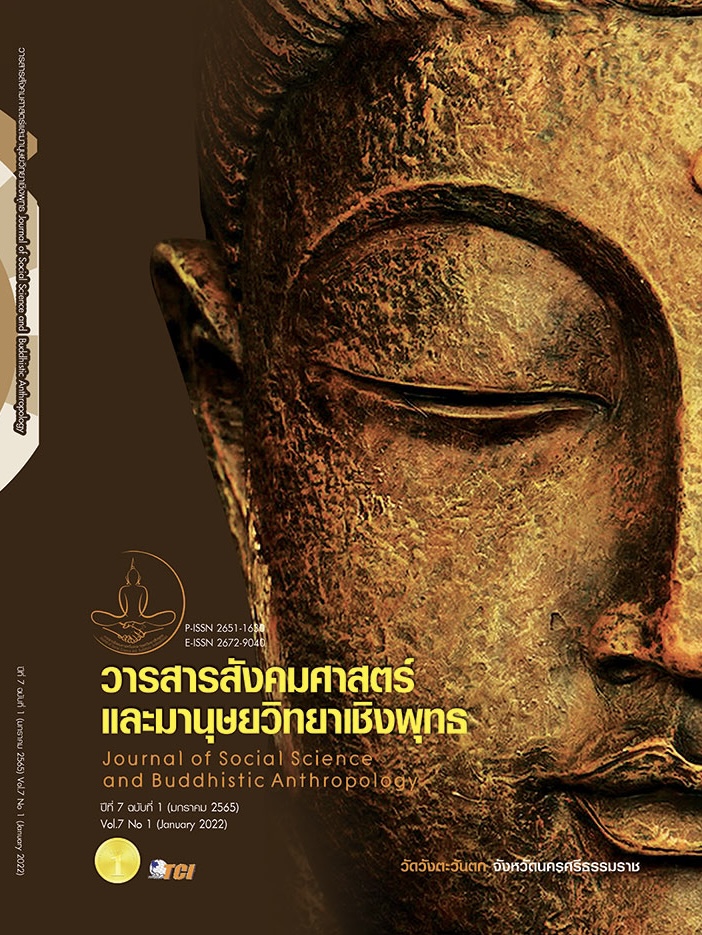THE STUDY OF ACADEMIC ACHIEVEMENT IN BIOLOGY ON THE STRUCTURE OF FLOWERING PLANTS WITH LEARNING MANAGEMENT USING THE BRAIN – BASE (BBL) OF STUDENTS IN SECONDARY SCHOOL 5
Keywords:
Academic achievement, Biology, learning management Using the brain - base (BBL), Students in Secondary SchoolAbstract
The objectives of this research article were to 1) study problems in biology class on the structure of flowering plants of students in secondary school 5 and 2) study achievement in biology on the structure of flowers before and after brain - based learning management (BBL) of students in secondary school 5. This research is classroom research using the population of students in secondary school 5 at Nakhonluang Udomratwitthaya school who studied biology, semester 1, academic year 2019, total 40 people. Questionnaire and papers for teaching and learning about the structure of plants with flowers with learning management by using the brain as a base (BBL) with a test of knowledge. The statistics used in this research are frequency, percentage, mean and standard deviation. The results of the research were as follows: 1) The students had the opinion that It is a difficult subject, requires quite a lot of memory causing the academic achievement to be not as good as it should be. By considering the top 3 problems, number 1 is the students still lacked knowledge and understanding about flowering plant structure. Number 2 is the content was unable to memorize and number 3 is the lack of doing the exercises 2) the learning achievement in biology of students in secondary school 5 matters about the structure of flowering plants with learning management by using the brain as a base (BBL), students have a better understanding of the structure of the flower plants. By observing the score before learning using the brain as a base (BBL) the mean is 15.52, the standard deviation is 3.55 and the score after learning using the brain as a base (BBL) mean is 32.50 with a standard deviation is 2.75.
References
กระทรวงศึกษาธิการ. (2544). พระราชบัญญัติการศึกษาแห่งชาติ พ.ศ. 2542. กรุงเทพมหานคร: ครุสภา.
กระทรวงศึกษาธิการ. (2551). หลักสูตรแกนกลางการศึกษาขั้นพื้นฐาน พุทธศักราช 2551. กรุงเทพมหานคร: โรงพิมพ์ชุมนุมสหกรณ์การเกษตรแห่งประเทศไทย จำกัด.
กัญญาวีร์ ชายเรียน และคณะ. (2559). การพัฒนารูปแบบการเรียนการสอนวิชาชีววิทยาโดยใช้ปัญหาเป็นฐาน ตามแนวทฤษฎีคอนสตรัคติวิสต์ เพื่อเสริมสร้างความสามารถในการคิดแก้ปัญหาสำหรับนักเรียนชั้นมัธยมศึกษาตอนปลาย. วารสารมหาวิทยาลัยราชภัฏลำปาง, 5(2), 18 - 32.
เชษฐ์ ศิริสวัสดิ์. (2556). การสอนให้คิดและสร้างสรรค์โครงงานวิทยาศาสตร์ด้วยการเรียนรู้เพื่อสร้างสรรค์ด้วยปัญญา. วารสารศึกษาศาสตร์, 24(1), 1 - 15.
ณพัฐอร บัวฉุน. (2558). การเปรียบเทียบผลสัมฤทธิ์ทางการเรียนสาระการเรียนรู้วิทยาศาสตร์ โดยใช้แบบฝึกเสริมทักษะ เรื่อง แรงและการเคลื่อนที่ ของนักเรียนชั้นมัธยมศึกษาปีที่ 1. วารสารวิจัยและพัฒนา วไลยอลงกรณ์ ในพระบรมราชูปถัมภ์, 8(4), 157 - 166.
ดวงจันทร์ วรคามิน และคณะ. (2559). การศึกษาความสามารถในการคิดและการมีจิตสาธารณะเพื่อพัฒนาศักยภาพการเป็นคนดีคนเก่งของนักเรียนไทย. วารสารมนุษย์ศาสตร์มหาวิทยาลัยธุรกิจบัณฑิตย์, 4(1), 26 - 39.
ทิศนา แขมมณี. (2555). ศาสตร์การสอน: องค์ความรู้เพื่อการจัดกระบวนการเรียนรู้ที่มีประสิทธิภาพ. กรุงเทพมหานคร: บริษัทด่านสุทธาการพิมพ์ จำกัด.
ประภัสสร จันทร์พูล. (2562). การเปรียบเทียบผลสัมฤทธิ์ทางการเรียน เรื่อง ต่อมไร้ท่อ วิชาชีววิทยา ระดับชั้นมัธยมศึกษาปีที่ 5 ระหว่างกลุ่มที่เรียนด้วยชุดแบบฝึกทักษะและกลุ่มที่เรียนด้วยวิธีการปกติ. ใน วิทยานิพนธ์ศึกษาศาสตรมหาบัณฑิต สาขานวัตกรรมหลักสูตรและการจัดการเรียนรู้ . มหาวิทยาลัยรามคำแหง.
พัชรี จักรชุม. (2552). การพัฒนาชุดกิจกรรมการเรียนรู้เพื่อเสริมสร้างความคิดสร้างสรรค์สาระพระพุทธศาสนา กลุ่มสาระการเรียนรู้รายวิชาสังคมศึกษาศาสนาและวัฒนธรรม ชั้นมัธยมศึกษาปีที่ 2. ใน วิทยานิพนธ์ครุศาสตรมหาบัณฑิต สาขาการบริหารการศึกษา. มหาวิทยาลัยราชภัฏสกลนคร.
พิมพันธ์ เดชะคุปต์. (2544). การเรียนการสอนที่เน้นผู้เรียนเป็นสำคัญ :แนวคิดวิธีและเทคนิคการสอน 1. กรุงเทพมหานคร: เดอะมาสเตอร์กรุ๊ฟแมนเนจเม้นท์.
ภาษกร แจ่มหม้อ. (2557). การพัฒนารูปแบบการจัดการเรียนรู้วิชาชีววิทยาแบบผสมผสานโดยใช้แหล่งข้อมูลเป็นหลัก เพื่อส่งเสริมความใฝ่เรียนรู้ สำหรับนักเรียนชั้นมัธยมศึกษาตอนปลาย. ใน ดุษฎีนิพนธ์ศึกษาศาสตรดุษฎีบัณฑิต สาขาการบริหารและพัฒนาการศึกษา. มหาวิทยาลัยนเรศวร.
เรวดี ศรีสุข. (2562). การประยุกต์ใช้ทฤษฎีการเรียนรู้แบบร่วมมือ (Co-operative learning) ในการออกแบบจัดการเรียนการสอน. วารสารวิทยาลัยพยาบาลบรมราชชนนี, 10(1), 13 - 26.
สุคนธ์ สินธพานนท์. (2558). การจัดการเรียนรู้ของครูยุคใหม่ เพื่อพัฒนาทักษะของผู้เรียนในศตวรรษที่ 21. กรุงเทพมหานคร: ห้างหุ้นส่วนจำกัด 9119 เทคนิคพริ้นติ้ง.
เสาวลักษณ์ ยิ้มประเสริฐ และคณะ. (2560). การจัดการเรียนรู้โดยใช้สมองเป็นฐานร่วมกับบทเรียนแท็บเล็ต เรื่อง ข้อมูลและคอมพิวเตอร์ นักเรียนชั้นประถมศึกษาปีที่ 2. วารสารครุศาสตร์อุตสาหกรรม, 16(2), 10 - 17.
Best, W. (1981). Research in education. New Jersey: Prentice Hall.
Cronbach. (1970). Essentials of Psychological Test (5th ed.). New York: Harper Collins.
Ministry of Education. (2017). National Education Plan. Bangkok: Office of the Education Council.
Downloads
Published
How to Cite
Issue
Section
License
Copyright (c) 2022 Journal of Social Science and Buddhistic Anthropology

This work is licensed under a Creative Commons Attribution-NonCommercial-NoDerivatives 4.0 International License.








